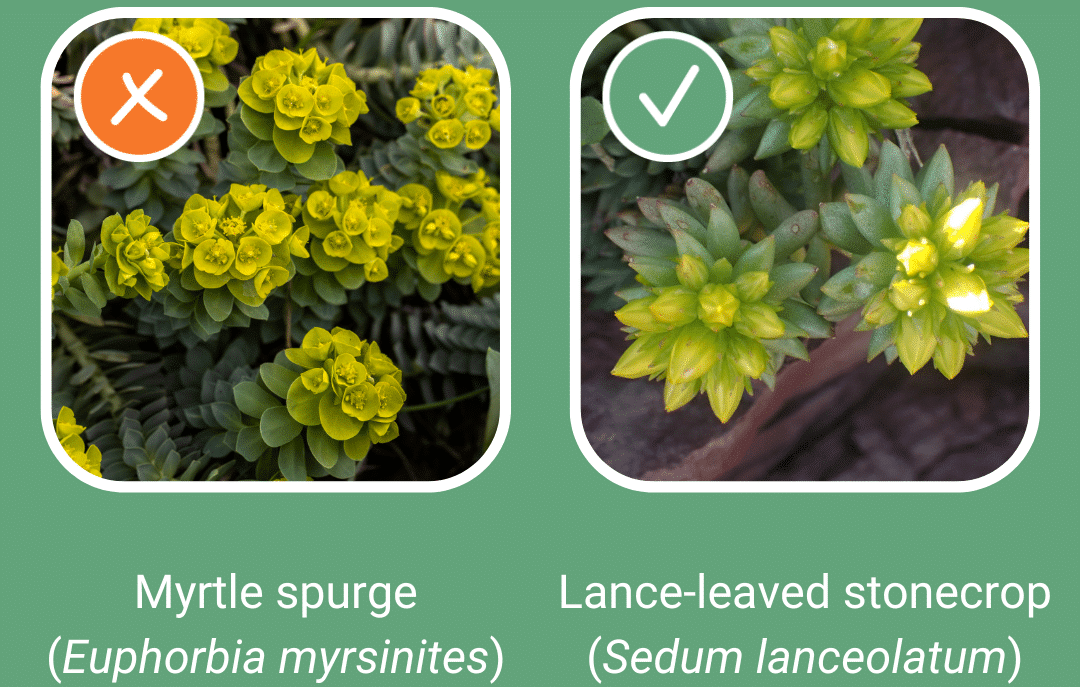By Lisa Houle | May 3, 2024
Every year the Province of BC proclaims May ‘Invasive Species Action Month’ (ISAM), recognizing the impact of invasive species on B.C.’s environment, economy, society, and human health. Over the coming weeks, we hope you’ll join us on an engaging and informative journey to learn how to identify, report, and manage invasive species, and get to know some of the easy ways we can all prevent their spread.
Free Webinar! Don’t miss Dr. Elizabeth Elle, Professor, Community and Evolutionary Ecology, SFU, who presents ‘Supporting our pollinators with native and non-invasive plants’ on Tues, May 7th from 12-1 pm PT: Register
As plants start colouring your world this spring, it’s helpful to learn what’s popping up. It’s especially important to get to know what’s invasive in your region, and what’s at stake. Some invasive plants can be dangerous to human health, and some are toxic to animals. Others crowd out native species, culturally significant species, and species at risk.
Here are five invasive plants found in many parts of B.C. Have you seen them in your region?
- If you’re looking for an attractive creeping perennial that plays well with other plants, this is not it. Myrtle spurge grows quickly and aggressively, releasing chemicals from its roots which stop other plants from growing near it. It is toxic to humans, livestock, and wildlife. Skin contact with the sap can also cause redness, swelling, blisters, and even blindness. We urge you to consider Lance-leaved stonecrop instead. This beautiful and hardy native succulent is low-maintenance, drought-tolerant, and pollinator friendly.

- This tall, exotic beauty is a heartbreaker. Every part of Foxglove is extremely poisonous. In fact, the compound digitalis, used in heart medication, was originally sourced from the Foxglove plant because of its effects on the cardiac system when ingested. A single plant can produce 5,000 seeds each season. We hope you’ll opt for something like Blazing star instead. This low-maintenance prairie species can tolerate a range of environmental conditions and is highly attractive to pollinators like hummingbirds and bees.

- This plant likes to wander, and it’s got great survival instincts. Purple loosestrife is a perennial that grows in wetlands, aquatic habitats, pastures, and roadside ditches. It spreads rapidly by seed and root fragments, and a mature plant can produce up to 2.5 million seeds that can survive in the soil for up to 20 years. Choose Spike speedwell instead, a similar-looking plant with a cool name that bees and butterflies love. You’ll be enjoying its blooms all summer long.

- ‘She ain’t pretty, she just looks that way.’ The Northern Pikes might have been singing about Daphne (Spurge-Laurel) given its glossy leaves and fragrant flowers. But Daphne is both poisonous and toxic, its sap causing skin rashes, nausea, swelling of the tongue, and coma. Left unchecked, it forms dense thickets and rapidly overtakes and outcompetes native vegetation. Instead, choose Tall Oregon grape for its glossy, holly-like leaves. Its bright yellow flowers appear on spikes, followed by masses of pale blue berries that are loved by birds and excellent in jams.

- It’s always the quiet ones you need to keep an eye on. The unassuming Oxeye daisy is found in many store-bought wildflower mixes despite its invasive nature. It is fast spreading and often found in pastures, grasslands, waste areas and along roadsides. Large infestations of Oxeye daisy can reduce forage for livestock and wildlife. Choose its lookalike, Cutleaf daisy, which comes in a variety of colours. This species is very drought and heat tolerant and does well in rocky, poor soils. Bonus: Cutleaf daisy is native to BC!

When selecting non-invasive plants for your garden, be sure to look for those suited to your location, including moisture requirements and hardiness zone. Check our website for more species identification, and take a free eLearning course anytime to learn more about invasive species.
Lisa is a Communications and Outreach Coordinator at ISCBC. She values a diverse environment and connecting with others about environmental protection. In her spare time Lisa enjoys spending time at the ocean and beach combing for sea glass. You can reach Lisa at lhoule@bcinvasives.ca
Share





